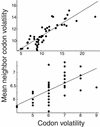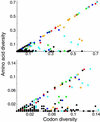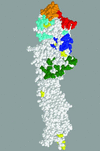Codon bias and frequency-dependent selection on the hemagglutinin epitopes of influenza A virus
- PMID: 12748378
- PMCID: PMC165845
- DOI: 10.1073/pnas.1132114100
Codon bias and frequency-dependent selection on the hemagglutinin epitopes of influenza A virus
Abstract
Although the surface proteins of human influenza A virus evolve rapidly and continually produce antigenic variants, the internal viral genes acquire mutations very gradually. In this paper, we analyze the sequence evolution of three influenza A genes over the past two decades. We study codon usage as a discriminating signature of gene- and even residue-specific diversifying and purifying selection. Nonrandom codon choice can increase or decrease the effective local substitution rate. We demonstrate that the codons of hemagglutinin, particularly those in the antibody-combining regions, are significantly biased toward substitutional point mutations relative to the codons of other influenza virus genes. We discuss the evolutionary interpretation and implications of these biases for hemagglutinin's antigenic evolution. We also introduce information-theoretic methods that use sequence data to detect regions of recent positive selection and potential protein conformational changes.
Figures



References
-
- Hayden, F. G. & Palese, P. (1997) in Clinical Virology, eds. Richman, D. D., Whitley, R. J. & Hayden, F. G. (Churchill Livingstone, New York), pp. 911-942.
-
- Fitch, W. M., Bush, R. M., Bender, C. A., Subbarao, K. & Cox, N. J. (2000) J. Hered. 91, 183-185. - PubMed
-
- Bush, R. M., Fitch, W. M., Bender, C. A. & Cox, N. J. (1999) Mol. Biol. Evol. 16, 1457-1465. - PubMed
Publication types
MeSH terms
Substances
Grants and funding
LinkOut - more resources
Full Text Sources
Other Literature Sources
Miscellaneous

